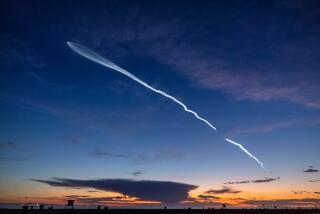U.S. Missile Base Braces for Soviet Inspectors
GREENHAM COMMON, England — Four and a half years after the first American medium-range missiles arrived at this sprawling air base amid violent protest and political nervousness, U.S. military officials are preparing to remove them.
The first important step in the process could come as early as next month, with the arrival of Soviet inspection teams.
Under the terms of the Intermediate-range Nuclear Forces Treaty completed June 1 in Moscow, which calls for the elimination of all U.S. and Soviet medium-range missiles, Moscow may conduct its first inspection on 16 hours’ notice anytime between 30 and 90 days after the treaty became effective with the exchange of documents.
Before this 60-day period ends, Soviet inspection teams are expected to visit all 26 of the U.S. medium-range missile sites scattered across Western Europe in order to confirm conditions at the start of the withdrawal.
At the same time, U.S. inspectors may visit the 133 Soviet medium-range missile bases in East Germany, Czechoslovakia and the western Soviet Union.
“We’re at the point in history that we wanted to get to long ago,” said Col. Bill Jones, commander of the 501st Tactical Missile Wing here. “I think we’ve validated what we wanted to do.”
The North Atlantic Treaty Organization decided nine years ago to deploy American cruise and Pershing 2 nuclear missiles in Europe in response to Moscow’s buildup of SS-20 missiles, and these weapons have long been viewed by U.S. officials as bargaining chips in negotiating the elimination of medium-range missiles.
Jones said Soviet inspectors at Greenham Common, each accompanied by two U.S. military officials, will be ushered through the four metal fences topped with concertina wire that surround the missile maintenance area and will be allowed to view missile system components, as provided for under the treaty. Sensitive material not subject to inspection will be covered, he said, adding: “There will be no cheating. I will feel very verified once they come and go.”
He said 29 Tomahawk missile launchers and 101 missiles are at the base, but he emphasized that the Soviet inspectors will be allowed to see only the canisters containing the missiles, not the missiles themselves.
During the Soviets’ maximum 4 1/2-day stay at the base, Jones said, they will be housed in special quarters but will be served “the menu of the day at the airmen’s dining facilities.”
Lt. Col. Ken Keating of the recently formed On-Site Inspection Agency said the cruise missiles will be returned to the United States from bases in Europe over the next three years and will be destroyed at Davis Monthan Air Force Base in Arizona, also under Soviet inspection.
“The missiles will be cut in half longitudinally,” Keating said. “They will then be little more than scrap metal.”
The Pershing missiles, which are based at Mutlangen, West Germany, are scheduled to be destroyed at the Long Horn Army Ammunition Depot in Marshall, Tex., and at another depot in Pueblo, Colo., Keating said.
Can Demand to See Sites
Over the next 13 years, the Soviets and Americans will be free to demand inspection of the missile sites on short notice.
Under the terms of the treaty, all the missiles are to be removed within three years, and Jones indicated that some could remain at Greenham Common for most of that period.
Greenham Common was the first base in Europe to receive the missiles. When the first planeload arrived in November, 1983, police were stationed every 30 yards around the perimeter fence, which extends for about nine miles, to prevent a crowd of anti-nuclear protesters from invading the base.
The protesters had considerable sympathy. Opinion polls at the time indicated that about 60% of the British public believed that the missiles increased the possibility of nuclear war.
A handful of the protesters, all women, have never left the area. Camping outside Greenham Common’s four gates through some of the worst winters of the century, they have blocked and harassed missile-launch vehicles leaving and entering the base.
“Never once has a convoy come out of those gates when it hasn’t been stopped,” said Anika Jones, seated near a campfire outside the main gate.
But, over the years, public attention has shifted away from the Greenham Common women. Internal differences have divided the protesters, and people in the nearby town of Newbury have turned against them.
Sarah Hipperman, who arrived here eight months before the first missiles in 1983, complained that she and those with her had been barred from local shops and pubs. She said she was recently thrown off a local bus after being identified as a protester.
Even as the military prepares for the missiles’ departure, the protesters vow to stay.
“I doubt if ratification means much,” Hipperman said. “It’s only 3% of the world’s nuclear missiles, and new systems are already designed to replace them. We’re here to take on militarism.”
Jones said the status of the Greenham Common base after the missiles are pulled out is being discussed by officials of the United States, Britain and NATO.
More to Read
Sign up for Essential California
The most important California stories and recommendations in your inbox every morning.
You may occasionally receive promotional content from the Los Angeles Times.










